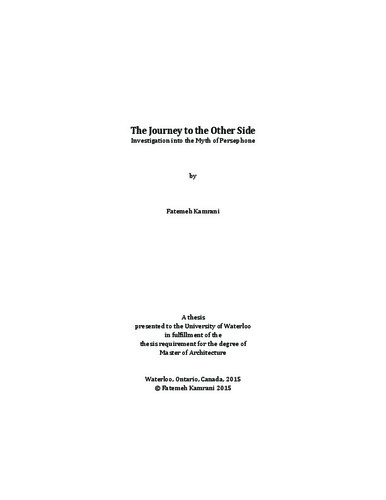| dc.description.abstract | This thesis is an exploration of chthonian architecture, which offers qualities that guide its visitor to the gate of the unconscious mind, which has always been the starting point of the holy trip of self-discovery. This journey’s map is taken from Carl Gustav Jung’s and his contemporaries’, theories of analytic psychology. Jung introduces myths as a powerful means to get in contact with the unconscious—specifically, the myth of Persephone. The Persephone myth is an extended explanation of a journey of metamorphosis that includes three phases: separation, stay/contemplation, and return. In order to analyze some ways in which these three steps have been translated into architecture, and how a space or structure can both symbolically and, potentially, literally take visitors on a journey of change and self-discovery like Persephone’s, the research is followed by an investigation of some architectural precedents, including grotto, Sheikh Lotfollah Mosque, the Jewish Museum, the Bruder Klaus Chapel, the Danteum, and some other architectural transitions.
The thesis finishes with a proposed architectural design synthesis that contains three parts, each representing a phase of transformation. The selected site of the architecture is the Huron Natural Area in Kitchener. So, by coming to the site—a natural setting—the visitor has already engaged in the first phase, separation, by removing himself or herself from everyday life and getting closer to his or her own nature. The design offers an abrupt descent underground via a spiral ramp that is a symbol of violation, a painful fall to the dark realm of Hades and a naïve hope for a saviour. At the second phase, the visitor experiences the underground architecture. In the language of myths, the underworld represents the unconscious, and entering the underground is like entering the human psyche. The last phase of the journey of metamorphosis, return, is represented by the visitor’s ascent back to the surface, and re-immersion in the everyday life of the city.
Going through all steps of the architecture offers the visitor an opportunity to experience thoughts and feelings that may cause transformation. The atmosphere of this architecture is very different from that of everyday buildings we step into. This architecture invites its visitors to meet a deeper layer of their self. | en |

